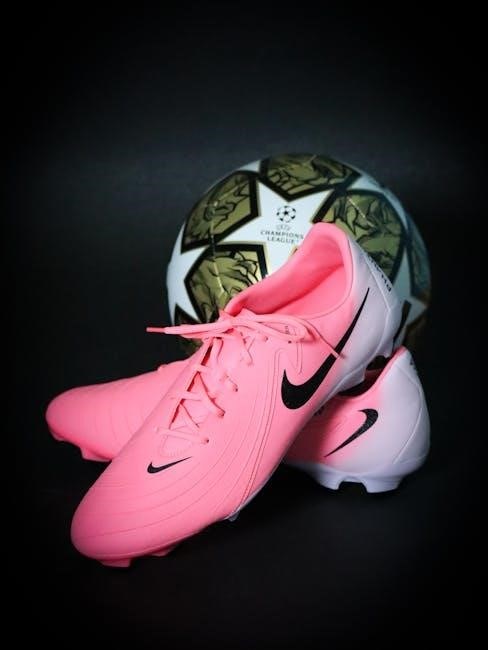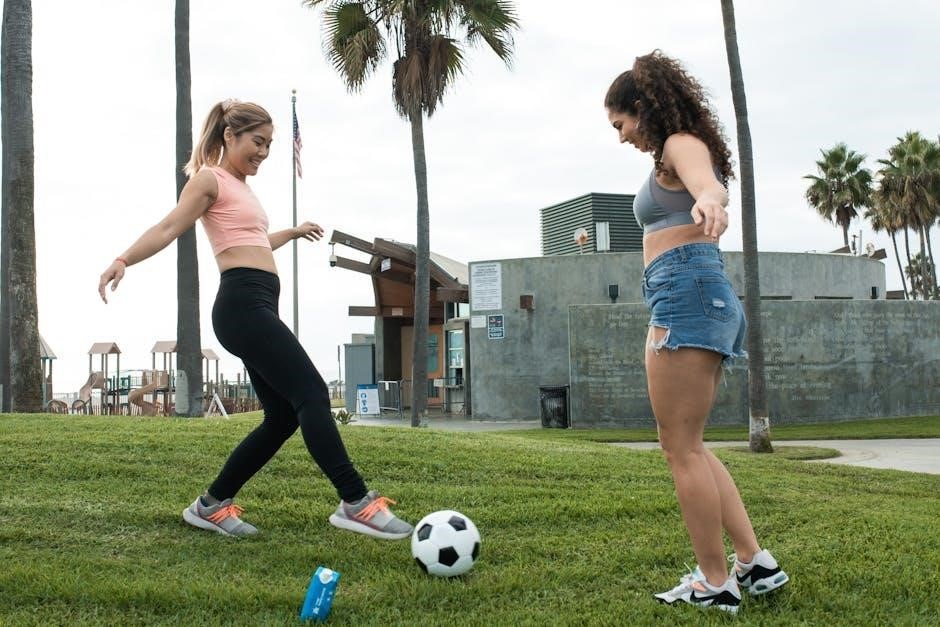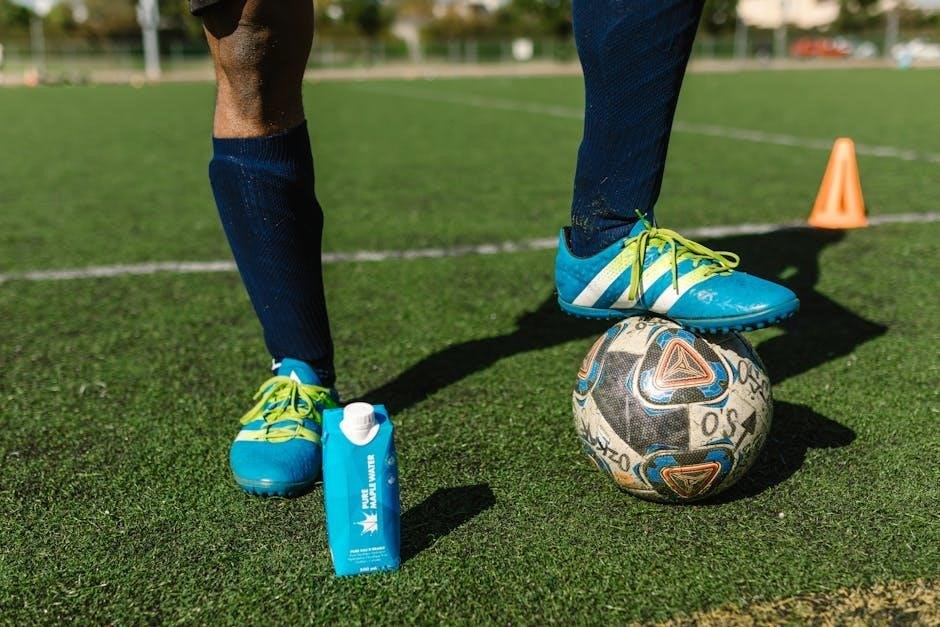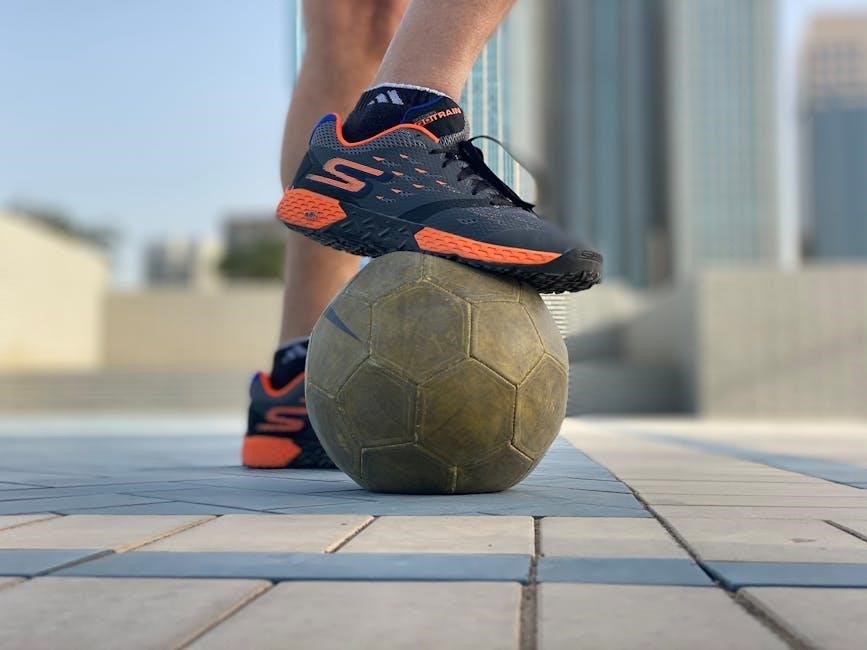Discover how to find your perfect soccer cleat fit with expert tips on sizing, foot shape, and brand-specific guides for optimal comfort and performance on the field.
Understanding the Importance of Proper Fit
A proper fit is crucial for performance, comfort, and injury prevention. Soccer cleats that are too tight can cause blisters and restrict movement, while shoes that are too loose may lead to slipping and poor control. Proper fit ensures optimal ball feel, agility, and stability, allowing players to perform at their best. Ill-fitting shoes can hinder mobility and increase the risk of discomfort or injury during games. Prioritizing the right fit is essential for both amateur and professional players to enhance their gameplay and overall soccer experience.
How Soccer Shoe Sizes Work
Soccer shoe sizes vary by brand and style, with standard charts guiding length and width measurements. Proper fit ensures optimal performance and comfort, requiring accurate sizing.
Standard Shoe Size Charts Explained
Standard shoe size charts provide a universal guide for determining shoe sizes based on foot length and width measurements. These charts vary slightly between regions, such as the US, UK, and Europe, but generally follow a consistent numerical or alphabetical system. For soccer cleats, accurate sizing is crucial for performance and comfort. Charts often include conversion tables to help compare sizes across different countries. Understanding these charts ensures a proper fit, as they account for variations in foot shape and brand-specific sizing differences. Always measure your feet in the afternoon, as they tend to swell slightly during the day, for the most accurate results.
How to Measure Your Foot Length Accurately
To measure your foot length accurately, start by wearing the same type of socks you plan to wear with your soccer cleats. Stand on a flat surface and place a flexible ruler or a standard ruler under your foot, ensuring it is aligned straight. Measure from the back of the heel to the tip of your longest toe. For precision, mark these points and measure the distance. Measure both feet, as they may differ slightly, and use the larger measurement for the best fit. Consider tracing your foot on paper for accuracy, especially if aligning the ruler is challenging. Finally, refer to a standard shoe size chart to translate your foot length into an appropriate shoe size, keeping in mind that different brands may have slight variations in sizing.
Understanding Foot Width and Its Impact on Fit
Foot width plays a crucial role in determining the comfort and performance of soccer cleats. While shoe size charts primarily focus on length, width variations can significantly affect fit. Narrow feet may feel constricted in standard-width cleats, potentially causing discomfort and restricting movement. Conversely, wider feet may require cleats designed for broader widths to prevent blisters and ensure proper support. Brands like Adidas offer styles catering to different widths, such as the Copa for regular widths and Predator for wider feet. Ensuring the right width ensures optimal fit, enhancing both comfort and performance on the field.
Factors Influencing Soccer Shoe Size
Foot shape, width, and personal comfort preferences significantly impact soccer shoe sizing. Different brands also offer varying fits, making it essential to consider these factors for optimal selection.
The Role of Foot Shape in Sizing
Foot shape plays a crucial role in soccer shoe sizing. Different cleats cater to various foot types, such as narrow, standard, or wide widths. Brands like Adidas offer models specific to foot shapes, ensuring a better fit. For instance, the Copa series suits regular-width feet, while the Predator line accommodates wider feet. Understanding your foot’s unique shape helps in selecting cleats that provide comfort and support, reducing the risk of discomfort or injury during play. This personalized approach ensures optimal performance and satisfaction on the field.
How Foot Width Affects Shoe Fit
Foot width significantly impacts soccer shoe fit, as it determines comfort and performance. Narrow or wide feet may require specific shoe styles, with brands offering varying widths. Ignoring foot width can lead to tightness or sloppiness, affecting mobility. Proper fit ensures even pressure distribution, preventing discomfort or injury. Measuring foot width accurately and consulting brand size charts helps in selecting the right cleats. Some brands, like Adidas, cater to different widths, ensuring a tailored fit for optimal performance and comfort during gameplay.
Personal Preference and Comfort Levels
Personal preference and comfort are crucial when selecting soccer cleats. While proper fit is essential, individual comfort levels vary. Some players prefer a snug fit for better control, while others opt for a slightly roomier feel. Factors like cushioning, material, and sock thickness also influence comfort. Trying on cleats with the same socks used in games ensures an accurate fit. Ultimately, the right balance between support and flexibility enhances performance and confidence on the field, making personal preference a key factor in choosing the perfect pair of soccer shoes.

How to Choose the Right Soccer Shoe Size
Measure your foot length and width accurately, try on shoes with the same socks you’ll wear, ensure a snug fit with enough toe room, and consider brand-specific sizing differences for optimal comfort and performance.
Trying On Shoes: What to Look For
When trying on soccer shoes, ensure they fit snugly with enough room for your toes to wiggle. Wear the same type of socks you’ll use during games. Check for a secure heel fit without slipping and adequate arch support. Press on the toe box to confirm there’s no excessive tightness. Walk around to ensure comfort and stability. Look for a balance between tightness and breathability, avoiding pressure points. Proper fit ensures better performance and reduces injury risk. Pay attention to width and how it matches your foot shape for optimal comfort and support during play.
When to Consider a Half Size Up or Down
If your standard size feels too tight, restricting mobility or causing discomfort, consider going half a size up. Conversely, if the shoe feels too loose, a half size down may provide a more secure fit. Pay attention to toe room and heel stability—ensuring there’s enough space for toes to wiggle without excessive movement. If you’re between sizes, prioritize comfort and performance. Trying shoes in the afternoon, when feet are slightly swollen, can help you make a more accurate decision. Adjusting by a half size can make a significant difference in fit and overall playing comfort.
How to Ensure a Snug, Comfortable Fit
Achieving a snug, comfortable fit requires careful attention to detail. Ensure your soccer cleats hug your feet without feeling restrictive. Start by wearing the same type of socks you’ll use during games to ensure accurate sizing. Check for adequate toe room—enough to wiggle your toes slightly but not so much that your foot slides. The heel should feel secure, with minimal slipping. If the fit isn’t perfect, consider a half size adjustment. Proper fit enhances performance and reduces injury risk, so take the time to get it right for optimal comfort and support on the field.

Brand-Specific Sizing Differences
Brands like Nike, Adidas, and others have unique sizing charts, so comparing their fit guides is crucial for ensuring the best match for your foot shape and preferences.
Nike Soccer Cleat Sizing Guide
Nike soccer cleats generally fit true to size, offering a snug, responsive feel. Use their size chart to match your foot length and width for optimal comfort. For precise measurement, measure your feet in the afternoon and wear the same socks you’ll use in games. If your standard size feels too tight, consider a half size up. Nike also offers a Fit Finder tool on their product pages to help determine your ideal fit based on specific cleat styles and your foot dimensions. This ensures a comfortable, performance-driven experience on the field.
Adidas Soccer Cleat Sizing Guide
Adidas soccer cleats are known for their snug, form-fitting design, particularly in styles like the X and Copa series. To ensure the best fit, measure your feet in the afternoon and refer to Adidas’ size chart. Their cleats cater to various foot widths, with options like regular and wide fits. For added precision, use Adidas’ Fit Finder tool, which helps determine your ideal size based on foot length and width. This ensures maximum comfort and performance, whether you’re playing on firm ground or artificial turf. Proper sizing is crucial for optimal support and agility during the game.
Other Popular Brands and Their Fit Characteristics
Each brand offers unique fit profiles. Puma cleats tend to run slightly narrower, ideal for slimmer feet, while New Balance provides a roomier toe box for wider feet. Umbro cleats are known for their soft, padded interiors, offering superior comfort. Mizuno cleats are designed with a focus on lightweight, snug fits, catering to players seeking agility. Always consult the specific brand’s size chart, as fit can vary significantly. Testing shoes in the afternoon and wearing soccer socks ensures the most accurate fit, maximizing comfort and performance during the game. This ensures you choose the best cleats for your foot shape and playing style.
Soccer Shoe Size Charts
Explore size conversion charts for men, women, and kids, covering US, UK, and European sizes, to ensure the perfect fit for your soccer cleats.
Men’s Soccer Shoe Size Conversion Chart
Use our detailed chart to convert men’s shoe sizes across US, UK, and European standards. Ensure accurate sizing by matching your foot length to the corresponding size, optimizing comfort and performance. This guide helps you find the perfect fit, whether you’re shopping domestically or internationally, with specific conversions for each region. Proper sizing enhances mobility and reduces injury risk, making it essential for any player. Refer to the chart below to find your ideal size and enjoy a snug, comfortable fit in your soccer cleats.
Women’s Soccer Shoe Size Conversion Chart
Our women’s soccer shoe size conversion chart helps you find the perfect fit across US, UK, and European sizes. Designed for accuracy, it ensures optimal comfort and performance. Measure your foot length and match it to the chart for precise sizing. Remember, proper fit reduces injury risk and enhances gameplay. Use this guide to convert sizes effortlessly, whether shopping domestically or internationally. Ensure your soccer cleats fit snugly by referencing the chart below, tailored to women’s foot shapes and sizes for the best possible comfort and support during matches.
Kids’ Soccer Shoe Size Conversion Chart
Our kids’ soccer shoe size chart provides a clear guide for converting sizes across US, UK, and European standards. Ensure your child’s cleats fit perfectly with accurate measurements. Regular foot growth means frequent size checks are essential. Use the chart to find the ideal fit for developing feet, ensuring comfort and support during games. Proper sizing prevents discomfort and potential injuries, helping your child perform at their best. This chart is designed to make shopping easier, whether online or in-store, ensuring your young player’s cleats match their foot shape and size seamlessly for optimal performance and joy in the game;

Fit and Comfort Tips
Ensure a snug, sock-like fit with enough toe room for comfort and flexibility. Avoid tightness that restricts movement, optimizing performance and reducing discomfort during play.
How Tight Should Soccer Cleats Be?
Soccer cleats should fit snugly, providing a sock-like feel without restricting movement. They should be tight enough to prevent slipping but not so tight that they cause discomfort or hinder performance. Proper tightness ensures better control, agility, and ball feel. If cleats are too loose, they may lead to blisters or reduced responsiveness. Conversely, overly tight cleats can cause discomfort and potentially lead to injury. The ideal fit allows for a small amount of toe room while maintaining a secure feel around the midfoot and heel. This balance is crucial for peak performance on the field.
The Importance of Toe Room
Adequate toe room in soccer cleats is essential for comfort and performance. It prevents toes from feeling cramped, reducing the risk of blisters and discomfort during gameplay. Proper toe room also allows for natural foot movement, enhancing control and agility on the field. Shoes that are too tight can hinder performance and lead to injuries. Ensure there’s enough space for toes to wiggle slightly, while maintaining a snug fit elsewhere. This balance ensures optimal comfort and peak performance.
Common Mistakes to Avoid When Sizing
One common mistake is not measuring foot length accurately, leading to ill-fitting shoes. Ignoring foot width can cause discomfort, as can buying cleats too tight or too loose. Many players skip trying shoes on, especially with the same socks they’ll wear during games. Others overlook personal comfort preferences, opting for styles that don’t suit their foot shape. Avoid relying solely on standard sizes, as brands vary. Lastly, neglecting to consider growth for kids’ shoes can result in frequent replacements. Proper sizing ensures optimal performance and comfort.
Breaking In Your Soccer Shoes
Break in new cleats gradually by wearing them for short sessions, ensuring comfort and preventing blisters. Proper break-in enhances performance and long-term durability of the shoes.
How to Break In New Cleats Properly
Breaking in new soccer cleats is essential for optimal comfort and performance. Start by wearing them for short periods, gradually increasing duration. Use the same socks planned for games. Walk or jog lightly to mold the cleats to your feet. Avoid tight lacing initially to prevent discomfort. If blisters occur, adjust lacing or consider a different size; Proper break-in ensures a snug fit, reduces injury risk, and enhances your overall playing experience. Consistency is key to achieving the perfect balance of support and flexibility in your cleats.
Wearing Tips for Optimal Comfort
For optimal comfort, wear moisture-wicking socks to keep feet dry during play. Ensure proper lacing to secure the foot without restricting movement. Choose cleats that match your foot shape and width for a natural fit. Allow enough room for toes to wiggle, preventing cramped conditions. Break in cleats gradually to avoid blisters. If discomfort persists, consider adjusting lacing or exploring a different size. Prioritize comfort to maintain performance and prevent potential injuries during matches. Properly fitted cleats enhance agility, control, and overall playing experience, making them essential for any soccer player.

Soccer Shoe Size Guide for Kids
Help growing feet thrive with the right fit. Measure kids’ feet regularly, as growth spurts can change size quickly. Choose cleats with a snug, comfortable fit, allowing room for expansion. Ensure proper support and flexibility to enhance performance and love for the game.
How to Measure Kids’ Feet Accurately
To measure kids’ feet accurately, start by having them wear the same socks they’ll use with their cleats, as sock thickness affects fit. Place the foot flat on the floor with the heel against a wall or straight edge. Use a ruler to measure the heel-to-toe length, ensuring the foot is not angled. Measure both feet, as sizes can differ, and take the larger measurement. Use a shoe size chart to convert the length to the appropriate size. Regular measurements are crucial, as kids’ feet grow quickly, ensuring proper fit for comfort and performance.
Choosing the Right Size for Growing Feet
When selecting soccer cleats for growing feet, it’s essential to balance fit and future growth. Opt for a snug yet comfortable fit, allowing a small amount of room for toes to wiggle. Avoid excessively large sizes, as this can cause instability during play. Consider brands offering width options to accommodate varying foot shapes. Regularly check fit as feet grow, typically every 3-6 months, and refer to size charts for accurate conversions. Proper sizing ensures support, prevents discomfort, and helps maintain performance levels throughout the season.
Properly fitting soccer cleats enhance performance, comfort, and safety. Use size guides, consider foot shape, and test fit to find your ideal pair for optimal gameplay.
Final Tips for Finding Your Perfect Fit
Ensure a snug yet comfortable fit by measuring your feet accurately and considering foot width. Try shoes in the afternoon as feet swell throughout the day. Opt for brands that cater to your foot shape, whether narrow or wide. Don’t hesitate to go half a size up if needed for toe room and mobility. Break in new cleats gradually to avoid discomfort. Most importantly, prioritize comfort and support to enhance performance and prevent injuries during gameplay.
